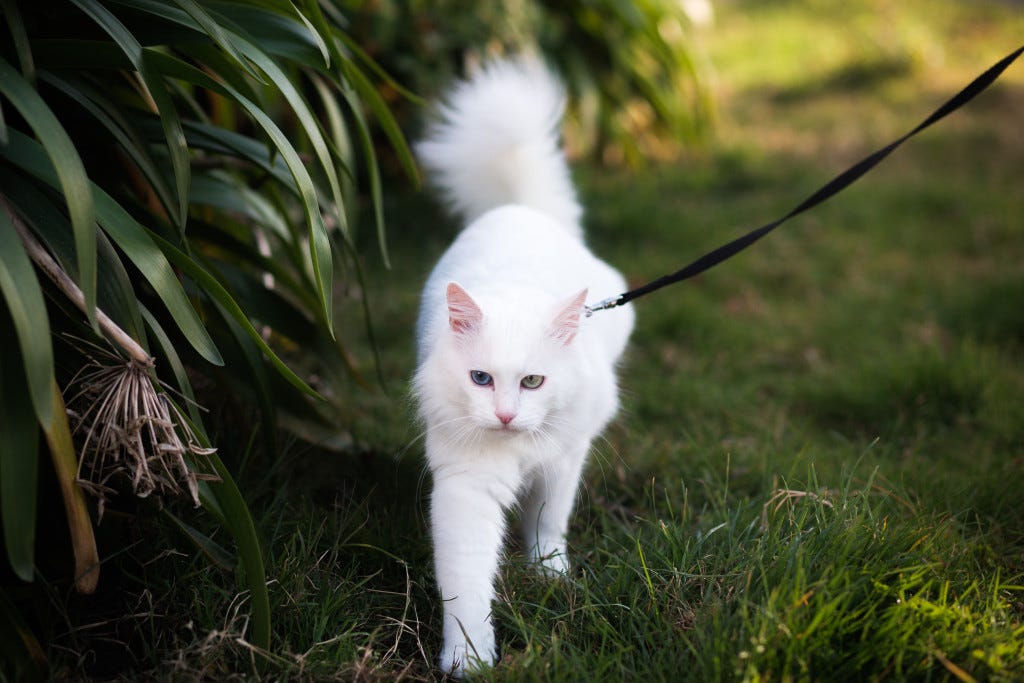Venturing outdoors stimulates and revitalizes your cat just as it does for humans. Have you ever heard your cat chattering by the window? You know she's looking at the birdies, deciding which one to make her prey. But, you keep her well fed, so she's not hunting because she's hungry; yet she still spends all that time at the windowsill each day. She must want to get outside!
Why not take your cat on an outdoor adventure? Sure, she might be timid at first, but with reassurance and experience, she might surprise you with her excitement for the great outdoors! You might even create some fur-ever memories.
Before you head out on an adventure, here are some tips to make sure you and Kitty are safe and prepared.
Start leash training early
Increasingly, cat parents are taking their kitties for walks outdoors (possibly due to the rise in people keeping their cats safely indoors). Use proper restraints to protect your cat from potential dangers, such as cars, dogs, other cats, and to prevent her from running off. But don't just grab any leash and collar; cats require different restraints from those used for dogs.
Guiding and pulling your cat on a leash attached to a cat collar can potentially injure Kitty's neck. Instead, it is recommended that you use a soft, squishy leash attached to a harness. If your fur baby is still a kitten, harness training should go pretty smoothly. For an older cat, it can take a few weeks to get him or her used to the apparatus.
Put the harness and leash on, carry him or her outside, and gauge Kitty's reaction. Be ready, though; some cats will try to wiggle out of their harness. It's key to create positive experiences with the harness and leash, so never punish your cat for struggling with it. Be gentle, prevent Kitty from successfully getting free, and speak kindly and warmly. Cats do not respond to punishment, so use positive reinforcement (like her favorite treats) to facilitate the training process.
Start harness and leash training for a few minutes at a time, building up to 30 minutes or more. Practice in a safe area (like a wide open park) that is free of traffic, other animals, and distractions. The best time to go for a walk is early in the morning or early evening, as long as the temperature isn't too extreme.
When you return home, give her plenty of treats and love as soon as you step inside (with Kitty's leash and harness still on). Soon, your cat will see her new gear and the walks as positive experiences.
Take your cat outdoors more often
Now that your cat is getting comfortable with a harness and leash, the world is your oyster! Walk through your neighborhood, visit pocket parks, brave a cat park if your neighborhood has one, and let Kitty get to know the community.

Be prepared to pick up and carry your cat if she gets tired or if larger animals approach. Cats feel safer from a higher vantage point, so don't be surprised if your cat tries to climb up on your shoulder or hop up on a low wall when dogs or a noisy truck pass by.
Depending on where you live, you might have to drive somewhere appropriate to walk—and we all know how harrowing kitty car rides can be. The younger your cat is when you introduce car trips, the easier it is. Utilize the same methods as the harness training above: be patient, positive, offer rewards, and don't punish.
In the beginning, don't measure success as a complete car ride; break up the process into steps to dispel Kitty's fears. Start by getting your cat in the harness, on the leash, and out to the driveway/garage next to the open car door. Then, suit up your cat and try to get her to hop in the car and sniff around; the next time, close the door and start the engine; the next time, roll out of your drive way and go around the block. It may seem tedious and time-intensive, but each instance may only need to be 5-15 minutes and the payoff (happy kitty car rides) is a worthwhile reward.
Learn to read your cat's needs
Before going any further on your cat adventures, brush up on how to read your cat. A good understanding of your cat's body language and habits will help you take care of him or her when you're outside of the house and routines are thrown off.
It's best to learn Kitty's habits at home and then see how they translate outdoors. When does your cat typically drink water or eat? How long before your cat feels like settling down for a rest? What are the behaviors that signal Kitty has to do her business? Pay attention to know when she is thirsty, tired, uneasy, or not enjoying the outdoors as you'd planned. Bring water, food, and treats, as well as appropriate bowls, and offer refreshments regularly.
To the nature!
Start venturing beyond neighborhood sidewalks or the familiar park to more natural settings. If you have a pond or lake nearby, go there for a walk. Bring a blanket and sit with your cat for a bit and watch the wildlife. If there's a nature trail through the woods, see how your cat likes it.
Eventually, you and Kitty will be ready to get out of town and into the nature. Take your cat on an outdoor adventure to find that there's nothing like bonding with your furry companion amid the beautiful scenery while hiking or camping.
Remember to keep your cat on a leash at all times, even if she comes when called; it's always better safe to be safe than sorry. An adventure requires you to expect the unexpected, so be prepared with the following items:
- pet first aid kit
- portable litter tray
- pop-up carrier or sling
- ID tags
- vet-approved sunscreen (cats can get sunburned!)
- water
- food
- treats
Make sure your cat is current on all necessary vaccinations, since you will surely encounter wildlife and/or their droppings.
In addition, carry a printed (not just digital) photo of your cat in case you become separated. It's a good practice to let family and friends know where you're going on your trip and for how long, so they can send help in case you don't return on time.
On the water
While cats are often stereotyped as hating water, that doesn't mean they'll hate going out on the water! While you're more likely to get wet going out on a boat, you don't have to go swimming. Some cats will take to the lulling seas, while others will resist. Like everything on this list, introduce your cat to boating slowly and offer positive reinforcement.
While the boat is docked, encourage Kitty to explore around and inside. In addition to a harness and leash, you should also introduce a pet life jacket. Once your cat is comfortable getting inside the boat, secure her leash to the boat while you go for a gentle lap. Let your cat hear the engine or watch you row and offer reassurance as she gets used to the idea that these are normal sounds and movements.
Once your cat is comfortable (more or less), head out on the water, making sure to pack the safety items mentioned above. With reassurance and experience, you may soon find Kitty is a natural sailor!
Have you seen this lovely Instagram account of adventurous cats? Where do you take your cat on an outdoor adventure?
Recommendations








